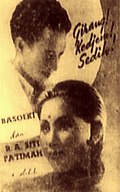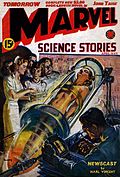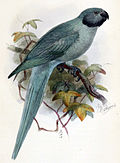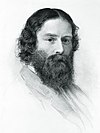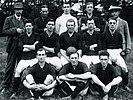Wikipedia:Today's featured article/February 2017
| << | Today's featured articles for February 2017 | >> | ||||
|---|---|---|---|---|---|---|
| Su | Mo | Tu | We | Th | Fr | Sa |
| 1 | 2 | 3 | 4 | |||
| 5 | 6 | 7 | 8 | 9 | 10 | 11 |
| 12 | 13 | 14 | 15 | 16 | 17 | 18 |
| 19 | 20 | 21 | 22 | 23 | 24 | 25 |
| 26 | 27 | 28 | ||||
February 1
Love, Inc. is an American television sitcom that originally aired for one season on United Paramount Network (UPN) from September 2005 to May 2006. Although it was developed as a vehicle and sitcom debut for Shannen Doherty, the series instead featured an ensemble cast led by Busy Philipps, Vince Vieluf, Reagan Gomez-Preston, Ion Overman, and Holly Robinson Peete (pictured) as five matchmakers working at a dating agency. It suffered from low viewership despite its high ratings among young Hispanic women; it was canceled following UPN's merger with The WB to launch The CW in 2006. The cancellations of this and other black sitcoms were criticized for reducing representation of African-American characters and reducing the number of roles for African-American actors on television. Critical response to Love, Inc. was mixed: some praised its multi-ethnic cast, while others felt that the storylines and characters were unoriginal and that Philipps' portrayal of her character was unsympathetic. (Full article...)
February 2
Suillus salmonicolor, the slippery Jill, is a fungus in the family Suillaceae. Its mushrooms appear scattered or in groups on the ground near the roots of pine trees, because the fungus exchanges nutrients with the roots in a mutually beneficial mycorrhizal association. It is found in North America (including Hawaii), Asia, the Caribbean, South Africa, Australia and Central America. The mushroom's dingy yellow to brownish cap, up to 9.5 cm (3.7 in) wide, can be rounded or flattened, and is slimy when wet. The small yellow pores on its underside become olive-brown with age. The stem is up to 10 cm (3.9 in) long and 1.6 cm (0.6 in) thick and is covered with reddish-brown glandular dots. Young specimens are covered with a grayish, slimy partial veil that later ruptures, leaving a sheathlike ring on the stem. Although the mushroom is generally considered edible—especially if the slimy cap cuticle and partial veil are first peeled off—opinions about its palatability vary. Similar species include S. acidus, S. subalutaceus, and S. intermedius. (Full article...)
February 3
Sexuality after a spinal cord injury (SCI) can still be satisfying, although the injury often causes sexual dysfunction. Physical limitations from SCI can affect sexual function, sexuality, and quality of life. Damage to the spinal cord impairs its ability to transmit messages between the brain and parts of the body below the level of the lesion, resulting in lost or reduced sensation and muscle motion, and affecting orgasm, erection, ejaculation, and vaginal lubrication. SCI can also impact sexuality when it leads to depression and an altered self-image. Even so, many people with SCI have satisfying sex lives, often including sexual arousal and orgasm. They can focus on different areas of the body and types of sexual acts, and often find newly sensitive erotic areas of the skin in erogenous zones or near borders between areas of preserved and lost sensation. Drugs, devices, and surgery can help men achieve erection and ejaculation. Although male fertility is reduced, many men with SCI can still father children. Women's fertility is not usually affected, although precautions must be taken for safe pregnancy and delivery. (Full article...)
February 4
Allen Walker is a fictional teenage character who appears as the protagonist of Katsura Hoshino's manga D.Gray-man, as well as two anime adaptations, three light novels, two video games, and several crossover fighting games. In the 19th century, the gentlemanly teenager joins the Black Order, a group of soldiers known as Exorcists, and fights Akuma demons and their creator, the Millennium Earl. In the anime television series and related franchise, he was voiced by Sanae Kobayashi. In 2016, for the new television anime series D.Gray-man Hallow, he was voiced by Ayumu Murase, and by Todd Haberkorn in an English-language anime series. The character has been popular with D.Gray-man readers, usually ranking in the top three in the series' popularity polls. Reactions to him have also been generally positive in manga and anime publications and other media. Critics have noted approvingly that his calm demeanor and mysterious origin are atypical of a protagonist in manga for boys. Merchandise featuring Allen Walker's likeness includes clothing and cosplay pieces. (Full article...)
February 5
The Courageous class was the first British multi-ship class of aircraft carriers. The three ships—Furious, Courageous and Glorious—were originally laid down as battlecruisers to be used in the Baltic Project during the First World War. They were very fast, but their minimal armour and guns limited their long-term utility in the post-war Royal Navy, until they were converted to aircraft carriers as permitted by the 1922 Washington Naval Treaty. Furious, already partially converted during the war, began reconstruction in 1921. As the first large carrier completed by the Royal Navy, the ship was used to evaluate aircraft handling and landing procedures, including the first-ever carrier night landing in 1926. During the Second World War, Courageous became the first British warship lost, torpedoed in September 1939 by a German submarine. Glorious, sailing home with minimal escort after the Norwegian Campaign, was sunk by two German battleships in June 1940. Furious ferried aircraft, escorted convoys and launched air attacks in support of British forces until late 1944. (Full article...)
Part of the Courageous-class battlecruisers featured topic.
February 6
Cliff Clinkscales (born 1984) is an American professional basketball player for the Halifax Hurricanes of the National Basketball League of Canada (NBL Canada). A 6-foot-1-inch (1.85 m) point guard, he was named an NBL Canada All-Star in 2014 and was the captain of his league champion team in 2016. In fifth grade in Jamaica, Queens, in New York, Clinkscales' performance at a local basketball camp led to a feature in Slam Magazine and appearances on The Oprah Winfrey Show and The Rosie O'Donnell Show. He received recruitment letters from the Kansas Jayhawks and University of Southern California Trojans. He first played high school basketball at Shores Christian Academy in Ocala, Florida. He played with the DePaul Blue Demons at the collegiate level, and was the National Collegiate Athletic Association Division I leader in assist-to-turnover ratio as a senior. He has been playing professionally since 2008 for the Erie BayHawks, Rio Grande Valley Vipers, Panama City Breeze, Halifax Rainmen and Halifax Hurricanes in the National Basketball Association Development League, the American Basketball League, and the NBL Canada. (Full article...)
February 7
Johnson Creek is a 25-mile (40 km) tributary of the Willamette River in the Portland metropolitan area of the U.S. state of Oregon. Part of the drainage basin of the Columbia River, its watershed covers 54 square miles (140 km2) of mostly urban land occupied by about 180,000 people. The creek flows generally west from the foothills of the Cascade Range through sediments deposited by glacial floods on a substrate of basalt. Though polluted, it provides habitat for salmon and other migrating fish along its free-flowing main stem. Prior to European settlement, the heavily forested watershed was used by Native Americans of the Chinook band for fishing and hunting. In the 19th century, white settlers cleared much of the land for farming. The stream is named for William Johnson, a settler who in 1846 built a water-powered sawmill along the creek. By the early 20th century, a rail line parallel to the stream encouraged further residential and commercial development. Damage from seasonal flooding grew as urban density increased in the floodplain. (Full article...)
February 8
The Good Terrorist is a 1985 political novel by Doris Lessing (pictured), a winner of the Nobel Prize in Literature. The story examines events in the life of Alice, a naïve and well-intentioned squatter, who moves in with a group of radicals in London, and is drawn into their terrorist activities. Lessing began writing The Good Terrorist after the Irish Republican Army (IRA) bombed the Harrods department store in London in 1983. She had been a member of the British Communist Party in the early 1950s, but later grew disillusioned with it. Some reviewers labelled The Good Terrorist as a satire; Lessing called it humorous. Some focused on Alice's ambivalent nature, as highlighted by the novel's oxymoronic title, describing her as neither a good person nor a good revolutionary. Some were impressed by the book's insight and characterisation, while others complained about its style and the characters' lack of depth. The novel was shortlisted for the Booker Prize, and won the Mondello Prize and the WH Smith Literary Award. (Full article...)
February 9
The USS Constellation captured the French L'Insurgente in a single-ship action between the frigates on 9 February 1799. The previous year, French privateering attacks against American vessels had led to the undeclared Quasi-War. Four US naval squadrons were sent to the Caribbean with orders to seize armed French vessels and prevent attacks on American ships. The squadron under Commodore Thomas Truxtun was on assignment in the waters between Puerto Rico and Saint Kitts when his flagship Constellation, cruising independently, met and engaged L'Insurgente, commanded by Michel-Pierre Barreaut. After chasing the French ship through a storm, Truxtun forced an engagement. The French frigate surrendered after 74 minutes with heavy casualties; the Americans sustained only a few casualties. L'Insurgente was taken to Saint Kitts and commissioned into the United States Navy as USS Insurgent. The action was the first victory over an enemy warship for the newly formed navy, and Truxtun was praised by the American government and public. (Full article...)
February 10
The Olympic marmot (Marmota olympus) is a rodent in the squirrel family, Sciuridae. It lives only in the U.S. state of Washington, at middle elevations on the Olympic Peninsula. About the size of a domestic cat, an adult weighs around 8 kg (18 lb) in summer. Its coat is brown all over with small whiter areas for most of the year, although the color changes with the season and with age. It has a wide head, small eyes and ears, stubby legs, and a long, bushy tail. Its sharp, rounded claws aid in digging burrows. It eats a variety of meadow flora, including the dry grasses that it uses as bedding in burrows. Its main predator is the coyote. Like its closest relatives, the hoary marmot and the Vancouver Island marmot, it hibernates seven to eight months a year. It is not endangered, and is protected by law in the Olympic National Park, which contains most of its habitat. Olympic marmots are social animals; they often engage in play fighting and use four different whistles to communicate. (Full article...)
February 11
Kedok Ketawa (The Laughing Mask) is a 1940 action film from the Dutch East Indies, in present-day Indonesia. After a young couple falls in love, the title character, a vigilante, helps them fight off criminals who have been sent to kidnap the woman by a rich man who wants her as his wife. It was the first film of Union Films, one of four new production houses established after the country's ailing film industry was revived by the success of Albert Balink's Terang Boelan. Kedok Ketawa was directed by Jo An Djan and stars Basoeki Resobowo, Fatimah, Oedjang (as the vigilante), S Poniman and Eddy Kock. Featuring fighting, comedy, and singing, and advertised as an "Indonesian cocktail of violent actions ... and sweet romance", the film received positive reviews, particularly for its cinematography. Following the success of the film, Union produced another six before being shut down in early 1942 during the Japanese occupation. Screened until at least August 1944, the film may be lost. (Full article...)
Part of the Union Films featured topic.
February 12
Bobby Peel (12 February 1857 – 12 August 1941) was an English professional cricketer who played first-class cricket for Yorkshire between 1883 and 1897. Although an effective batsman, he was primarily a left-arm spin bowler; when conditions favoured his bowling style, he was a matchwinner. Between 1884 and 1896, Peel was regularly selected to represent England, playing 20 Test matches in which he took 101 wickets; in one such game, he bowled England to victory after they had followed on in Australia in 1894–95. Peel began playing for Yorkshire in 1883 and was the team's main spinner by 1887; he regularly took over 100 wickets in a season, despite receiving little support from other bowlers, and was among the leading batsmen for the county. As a player, he was very popular but had a reputation for drinking heavily. In 1897 he was suspended for drunkenness during a match and never played for Yorkshire again, although the events leading up to this are unclear. Later stories, generally dismissed by historians, suggested he urinated on the pitch. He continued to play and coach cricket for most of his life. Among his other jobs, he became the landlord of a public house and worked in a mill. (Full article...)
February 13
Marvel Science Stories was a U.S. pulp magazine with fifteen issues in two separate runs, both edited by Robert O. Erisman and published by Abraham and Martin Goodman. The first issue, dated August 1938, carried stories with more sexual content than was usual for the genre, including several stories by Henry Kuttner. Reader reaction was generally negative; one referred to Kuttner's story "The Time Trap" as "trash". The magazine was cancelled after the April 1941 issue, but when a boom in science fiction magazines began in 1950, the publishers revived it. The first issue of the new series was dated November 1950; a further six issues appeared, with the last dated May 1952. Contributors to the first run included Arthur J. Burks and Jack Williamson; the second run published stories by better-known writers, including Arthur C. Clarke, Isaac Asimov, Jack Vance and L. Sprague de Camp. But many of the writers were publishing their best work elsewhere, and the second incarnation of the magazine did not succeed in the more competitive market of the 1950s. (Full article...)
February 14
Epsilon Eridani is a star in the constellation of Eridanus. Viewable from most of Earth's surface along a declination 9.46° south of the celestial equator, it is 10.5 light-years away and has an apparent magnitude of 3.73. It is the third-closest individual star or star system visible to the unaided eye. Estimated at less than a billion years old, the young star has a higher level of magnetic activity than the present-day Sun, with a stellar wind 30 times as strong. Epsilon Eridani is smaller and less massive than the Sun, with a greater proportion of hydrogen and helium. It is a main-sequence star of spectral class K2, which means that energy generated at the core through nuclear fusion of hydrogen is emitted from the surface at a temperature of about 5,000 K, giving it an orange hue. Observations for more than twenty years have yielded evidence of a giant planet orbiting the star, making it one of the nearest systems with a candidate exoplanet. The detection of this planet, Epsilon Eridani b, was announced by Bruce Campbell, Gordon Walker and Stephenson Yang in 1987. (Full article...)
February 15
Léal Souvenir is a 1432 oil-on-oak panel portrait by the Early Netherlandish painter Jan van Eyck. The panel was purchased in 1857 by the National Gallery, London, where it is on permanent display. The sitter has not been identified, but his individualistic features suggest a historical person rather than the hypothetical ideal usual in contemporary northern Renaissance portraiture. The portrait contains three layers of painted inscriptions, each rendered to look as if chiseled into stone. The first inscription is in a form of Greek and seems to spell "TYΜ.ωΘΕΟC", which has not been satisfactorily interpreted but has inspired some to title the work Timotheus. The middle lettering reads in French Leal Souvenir ("Loyal Memory") and indicates that the portrait is commemorative, completed after the man's death. The third records van Eyck's signature and the date of execution. The sitter's features have been described as "plain and rustic", yet he is presented as thoughtful and inward-looking. Art historians have detected mournfulness in his expression. (Full article...)
February 16
Zero Escape: Virtue's Last Reward is an adventure video game developed by Chunsoft. The second installment in the Zero Escape series, it was first released on February 16, 2012, for the Nintendo 3DS and PlayStation Vita. The story follows the player character Sigma, a man who is abducted and forced along with eight other individuals to play the life-or-death Nonary Game. The characters begin to unravel its secrets and its true purpose. Virtue's Last Reward was developed as a result of the unexpected critical success that its predecessor, Nine Hours, Nine Persons, Nine Doors, received in North America. Game director Kotaro Uchikoshi wrote the script, which was localized for North America by Aksys Games, and for Europe by Rising Star Games. Although critics were divided in their opinions of the escape-the-room sections, they gave Virtue's Last Reward positive reviews, especially for its story and characters. Nevertheless, the game was a commercial failure in Japan, which led to the temporary cancellation of its sequel. Development eventually resumed, and Zero Time Dilemma was released in 2016. (Full article...)
February 17
Newton's parakeet (Psittacula exsul) is an extinct species of parrot that was endemic to the Mascarene island of Rodrigues in the western Indian Ocean. Several of its features diverged from related species, indicating long-term isolation and adaptation on Rodrigues. Around 40 centimetres (16 in) long, Newton's parakeet was roughly the size of the rose-ringed parakeet, a close relative and probable ancestor. Its plumage was mostly greyish or slate blue, although most species in its genus are green. Little is known about its behaviour; it may have fed on nuts of the bois d'olive tree, along with leaves. It was very tame, and was able to mimic speech. Newton's parakeet was first written about by the French Huguenot François Leguat in 1708, and was mentioned only a few times by other writers. The bird became scarce due to deforestation and perhaps hunting, and was probably wiped out by a series of cyclones and storms that hit Rodrigues in the late 19th century. Only two specimens remain, both from the 1870s. (Full article...)
February 18
Southern Cross is the sole wordless novel by Canadian artist Laurence Hyde (1914–1987). Published in 1951, its 118 wood-engraved images describe the effect of atomic testing on Pacific Islanders. Hyde (pictured) made the book to express his anger at the US military's nuclear tests in the Bikini Atoll. The story tells of the American military evacuating villagers from an island before testing nuclear weapons. A drunken soldier attempts to rape a fisherman's wife during the evacuation, and the fisherman kills him. Their child witnesses the death of its parents and destruction of its environment from the atomic tests. The wordless novel genre had flourished primarily during the 1920s and 1930s, but by the 1940s even the most prolific practitioners had abandoned it. Hyde was familiar with some such works by Lynd Ward, Otto Nückel, and the form's pioneer Frans Masereel. The high-contrast artwork of Southern Cross features dynamic curving lines uncommon in wood engraving and combines abstract imagery with realistic detail. (Full article...)
February 19
Brougham Castle, founded by Robert de Vieuxpont in the early 13th century, is south-east of Penrith, Cumbria, England, on the site of Brocavum, a Roman fort. The castle is scheduled as an Ancient Monument, along with the fort, as "Brougham Roman fort and Brougham Castle". The Vieuxponts were a powerful land-owning family in North West England and also owned the castles of Appleby and Brough. When Brougham Castle was built, Vieuxpont was one of a few lords loyal to the king in the region. In 1264 his grandson, also named Robert, was declared a traitor and his property was confiscated by Henry III. Brougham Castle and the other estates were eventually returned to the Vieuxpont family. The castle ruins were mentioned at the start of William Wordsworth's poem The Prelude, and were the subject of his Song at the Feast of Brougham Castle upon the Restoration of Lord Clifford, the Shepherd, to the Estates and Honours of his Ancestors. They also inspired a painting by J. M. W. Turner. The castle was left to the Ministry of Works in the 1930s and is today maintained by its successor, English Heritage. (Full article...)
February 20
The Turboliners were a family of gas turbine trains built for Amtrak in the 1970s. They were purchased by Amtrak to update its fleet with faster, more modern trains. The first batch, known as RTGs, were built by the French firm ANF and entered service on multiple routes in the Midwestern United States in 1973. The new trains increased ridership wherever they were used, but the high cost of operating the trains led to their withdrawal from the Midwest in 1981. The second batch, known as RTLs (example pictured), were of a similar design but manufactured by Rohr Industries, an American company. These entered service on the Empire Corridor in the State of New York in 1976. The RTLs remained in service there through the 1990s, supplemented by several rebuilt RTGs. In the late 1990s and early 2000s, New York and Amtrak partnered to rebuild the RTLs for high-speed service; this project failed and Amtrak withdrew them from service in 2003. After the settlement of legal issues, the last RTLs were sold for scrap in 2012. (Full article...)
February 21
Djedkare Isesi was an Ancient Egyptian pharaoh, the eighth ruler of the Fifth Dynasty in the late 25th century to mid 24th century BCE, during the Old Kingdom period. His reign, probably over 40 years long, heralded a new period in the history of the Old Kingdom. Breaking with a tradition followed by his predecessors since the time of Userkaf, Djedkare did not build a temple to the sun god Ra, possibly reflecting the rise of Osiris in the Egyptian pantheon. More significantly, Djedkare effected comprehensive reforms of the Egyptian state administration, the first undertaken since the inception of the system of ranking titles. He also reorganised the funerary cults of his forebears buried in the necropolis of Abusir and reformed the corresponding priesthood. Djedkare commissioned expeditions to Sinai to procure copper and turquoise, to Nubia for its gold and diorite and to the Land of Punt for its incense. One such expedition had what could be the earliest recorded instance of oracular divination intended to ensure an expedition's success. (Full article...)
February 22
James Russell Lowell (February 22, 1819 – August 12, 1891) was an American Romantic poet, critic, editor, and diplomat. He was the first editor of The Atlantic Monthly and was one of the Fireside Poets, a group of New England writers who wrote poetry suitable for families entertaining at their firesides, with conventional forms and meters. His first collection of poetry was published in 1841. He was involved in the movement to abolish slavery, using poetry to express his anti-slavery views. In 1848 he gained notoriety with the publication of A Fable for Critics, a book-length poem satirizing contemporary critics and poets. The same year, he published The Biglow Papers, in which he tried to emulate the true Yankee accent in the dialogue of his characters. This depiction of the dialect and his satires were an inspiration to writers like Mark Twain and H. L. Mencken. Lowell went on to publish several other poetry and essay collections, and in later years was ambassador to the Kingdom of Spain and the Court of St James's. (Full article...)
February 23
King's Highway 402 is a 400-series highway in the Canadian province of Ontario and a vital trade link with the Midwestern United States, connecting the Blue Water Bridge international crossing near Sarnia to Highway 401 in London. The controlled access freeway is four-laned for nearly its entire length, widening at the approach to the Blue Water Bridge. It originally ended within the Sarnia city limits, merging into Highway 7 near the present Highway 40 interchange. Although it was one of the original 400-series highways, it was not completed until 1982; construction extending it to London began in 1972 and was completed with the final link between Highway 81 and Highway 2. The entire route became a controlled-access highway with the removal of an intersection at Front Street in Sarnia. Highway 402 offers access to Interstate 69 (I-69) and I-94 into Port Huron, Michigan, as well as Toronto via Highway 401, and onwards to Montreal via A-20 in Quebec. The only town along Highway 402 between Sarnia and London is Strathroy. (Full article...)
February 24
Westcott railway station served the village of Westcott, Buckinghamshire, near Baron Ferdinand de Rothschild's estate at Waddesdon Manor. It was built by the Duke of Buckingham in 1871 as part of a short horse-drawn tramway that met the Aylesbury and Buckingham Railway at Quainton Road. The next year, it was converted for passenger use, extended to Brill railway station, and renamed the Brill Tramway. The poor quality locomotives running on the cheaply built and ungraded line were very slow, initially limited to 5 miles per hour (8 km/h). The line was taken over by the Metropolitan Railway in 1899, and transferred to public ownership in 1933. Westcott station became part of the London Underground, despite being over 40 miles (60 km) from central London, until the closure of the line in 1935. The station building and its associated house (pictured) are the only significant buildings from the Brill Tramway to survive other than the former junction station at Quainton Road. (Full article...)
Part of the Brill Tramway featured topic.
February 25

Theodore Komnenos Doukas (died c. 1253) ruled Epirus and Thessaly from 1215 to 1230, and most of Macedonia and western Thrace as Emperor of Thessalonica from 1224 to 1230. He was also the power behind the rule of his two sons John and Demetrios over Thessalonica in 1237–46. The scion of a distinguished Byzantine aristocratic family, he was called to Epirus by his bastard half-brother Michael I Komnenos Doukas, who had founded an independent principality there after the Fourth Crusade. When Michael died in 1215, Theodore assumed governance and allied with Serbia, taking the Latin Kingdom of Thessalonica in 1224. He declared himself emperor, challenging the claims of the Nicaean emperor John III Vatatzes on the Byzantine imperial throne. In 1230 he amassed an army to besiege Constantinople, but diverted it to fight in Bulgaria, where he was defeated, blinded, and imprisoned for seven years. In 1237 he installed his older son John, and later Demetrios, as emperor in Thessalonica, remaining the de facto regent of the state. He was taken prisoner again in 1252 by Vatatzes and sent into exile in Nicaea, where he died the next year. (Full article...)
February 26
York City Football Club has a long history as a professional association football club based in York, England. Founded in 1908, they played several seasons before and after the First World War in the Northern and Midland leagues. They were elected to play in the Football League for 1929–30, in the Third Division North. They had their best FA Cup season in 1954–55, when they reached the semi-final, but lost to the First Division club Newcastle United in a replay. York played in the Third Division North until 1958–59, when a league reorganisation landed them in the Fourth Division. The same season, they finished third and won their first promotion. Their only promotion into the Second Division came in 1973–74. By mid-October 1974, they were in fifth place—their highest league ranking—before finishing the season in 15th place. They faced two successive relegations in 1976 and 1977, and a 22nd-place finish in the 1977–78 Fourth Division forced the club to apply for re-election. (Full article...)
Part of the York City F.C. featured topic.
February 27
Henry Hoʻolulu Pitman (1845–1863) was one of more than one hundred Native Hawaiians and Hawaiian-born combatants who fought in the American Civil War while Hawaii was still an independent kingdom. His father was a merchant from Massachusetts and his mother, Kinoʻoleoliliha, was a Hawaiian noble. He returned to the United States with his father for his education, but ran away from school without his family's knowledge and enlisted in the Union Army as a private. Despite his mixed-race ancestry, he avoided the racial segregation imposed on other Hawaiian recruits of the time and was assigned to a white regiment. He fought in the Battle of Antietam and the Maryland Campaign and befriended Robert G. Carter, a memoirist of the Civil War. On the march to Fredericksburg, he was separated from his regiment and captured by Confederate guerrilla forces. He was marched to Richmond and incarcerated in Libby Prison, where he contracted a lung disease from the harsh conditions. He died on February 27, 1863, after his release on parole in a prisoner exchange. His legacy has sparked renewed interest in the role Hawaiians played in the Civil War. (Full article...)
February 28
Banksia attenuata, the candlestick banksia, is a tree in the family Proteaceae. Commonly reaching 10 m (33 ft), it can be a shrub of 0.4 to 2 m (1.3 to 6.6 ft) in dryer areas. It has long narrow serrated leaves and bright yellow inflorescences, or flower spikes. It is found across much of the southwest of Western Australia, from north of Kalbarri National Park south to Cape Leeuwin and then east to Fitzgerald River National Park. Robert Brown named the species in 1810. Within the genus Banksia, the close relationships and exact position of B. attenuata are unclear. The tree is pollinated by and provides food for a wide array of vertebrate and invertebrate animals in summer months, including the honeyeaters and the honey possum, a tiny marsupial. The plant regenerates from bushfire by regrowing from its woody base or from epicormic buds within its trunk. It can live for up to 300 years. It has been widely used as a street tree and for amenities planting in urban Western Australia, though its large size generally precludes use in small gardens. A dwarf form is commercially available in nurseries. (Full article...)










